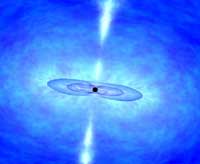|
Gamma ray radiation has both the shortest wavelength, from 0.01 – 10 nanometers, and the highest frequency wavelength within the electromagnetic spectrum. Violently exploding stars and their collapsed remnants
such as the ultra-compressed neutron stars and the all-consuming
black holes, produces these gamma rays (and x-rays). These light rays are many times more powerful than the optical
radiation (visible light) we can see with our eyes. Now these explosions, most of which occurred light
years away in the past, can be seen!
Gamma ray radiation is completely
blocked by the earth's atmosphere, and must be observed from satellites in space. Some satellites carry
specialized CCDs to detect X-rays, while other satellites have proportional counters: big lumps of crystal or
gas that absorb an incoming ray and release a charge which flows into an electrical circuit. Gamma
rays don't reflect well off mirrors. Some satellites focus on a region of the sky by blocking out the other
regions, while others have mirrors that deflect light by only a small angle.
The Sloan Digital Sky Survey (SDSS) is using instruments, sensitive to gamma rays and x-rays, to map our
universe and help us understand the beginnings of time. This is quite a fascinating undertaking!
The European Space Agency (ESA) is another group focused on gamma rays. Their gamma-ray satellite,
INTEGRAL presented ground-breaking images of a gamma-ray burst in 2002. The IBIS Digital imager, the SPI
spectrometer , an x-ray monitor and an optical monitor were used to record the gamma-ray data. Since
gamma-rays go straight through matter, their photons can’t be isolated and refracted in the
conventional manner via a glass lens. Instead, their energy is measured indirectly by causing their
photons to interact with a material placed in that camera. This results in the loss of an electron
from the gamma ray and will scatter the photon, thus causing its wavelength to get larger and become recordable.. This method of isolating gamma-rays is called the Compton scattering. These gamma-ray images are helpful in showing scientists areas where hydrogen has collided with cosmic rays in space.

To the right is INTEGRAL's view of that gamma-ray burst seen on December 18, 2002.
Integral's Principal Investigators, the scientists responsible for the instruments on board, explained the crucial role that high-energy missions like Integral played in astronomy. “X-ray and gamma-ray astronomy is a pathfinder to unusual objects. At optical wavelengths, the number of stars is staggering. At X-ray and gamma-ray wavelengths, there are fewer objects, but the ones that remain are the really peculiar ones.”

These extraordinary celestial explosions are unpredictable, occurring from random directions about twice a day. To the left is another, more recent view of a gamma burst taken by the High Energy Transient Explorer (HETE) Satellite.
Artificially produced gamma rays are also a vital tool for diagnosing medical disease and they have been used to determine the yield in an underground nuclear test. They also help with homeland security in the USA today. They can tell us about the origins of our universe because they can make visible to us the magnanimous bursts and explosions that took place light years ago.
|









